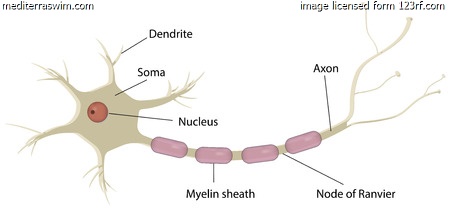Forums › Library › Training FAQ › How Does Imprinting A New Skill Work?
Please type your comments directly in the reply box - DO NOT copy/paste text from somewhere else into the reply boxes - this will also copy the code behind your copied text and publish that with your reply, making it impossible to read. Our apology for the inconvenience, but we don't see a convenient way of fixing this yet.
Tagged: brain, catch, imprinting, neurologic, skill building
-
AuthorPosts
-
January 18, 2017 at 16:37 #12338
Admin Mediterra
KeymasterFor the purpose of explaining how imprinting works, let us use the example of learning the catch…
Imprinting The Catch
Think of the motor skill for the catch as a new appliance hooked up to an electrical system with a circuit breaker. But in this organic electrical system, when you hook up a new appliance, the new wires connecting this new appliance are very thin, and are without insulation (myelin). Thick wires can handle more intensity, while insulation allows the signal to travel faster and with more precision. The wires only get thicker and get wrapped with insulation as you repeatedly send signals down that new wire to stimulate the connection. BUT if you send signals too fast or too hot for that new thin wire it trips the circuit breaker and shuts down your control. The brain shifts back over to some old motor pathway to finish the job. In this case your old catch pattern (dropped elbow???) is the default.
So at first, you can only send low intensity signals down that wire, but you can do it as frequently as you have time for. Repetition with precision stimulates the growth you want. Practice with concentration and more practice. Day by day and that wire gets a bit thicker and a bit more insulated. And gradually, by patient persistence the circuit will be ready and even urging you to send a more intense signal down that wire.
Stimulate One Circuit, Let The Other Atrophy
But there are two sides to the training effort: Intentional stimulation of the new circuit and intentional atrophy of the old one. You’ve got to make the old one wither away from disuse so that it is no longer there to fall back on. [I’ve imprinted my stroke this way so deeply that even under intentionally designed 3-hour swims with no food or water meant to test myself under complete energy drain I have no bad stroke to fall back into- I stay balanced, long and streamlined, and the catch stays the same – its the only position my body knows now – but I just don’t have any more acceleration to offer. Now I don’t worry about my stroke falling apart under stress like that.]
So, in your case, you need to develop a discipline for making incremental increases in intensity. You can’t work a little in first gear and then expect to jump into 5th gear suddenly and go. You’ll spend a season in 1st gear, and then 2nd gear and then 3rd and then 4th, and finally imprint it at highest intensities. You can always experiment and play up and down that intensity ladder, but failure is sending you a message. Read it.
Practice in incremental increases just up to failure point, assess why it failed, modify your approach, and then work around that failure point. There is far more likelihood that it fails because of concentration waning than because of strength is waning. This is neurological exhaustion.
How Long Does It Take?
It will depend on a lot of things!
It depends on how strong your foundational skills in balance and streamline are that support propulsive skills like the catch. If your balance is impeccable and you’ve developed active streamline (spearing hand pierces the water at the moment you set the catch- and you have a compact streamline kick behind you) then EVF will be much easier and much safer to develop. If you are completely stable at higher intensities and tempos then you will have a much easier time imprinting an adjustment like this to your catch because then your hand will be able to focus completely on holding water rather than stabilizing a wobbly body. If not, you will struggle a great deal under higher intensities and take greater risk against your shoulder health.
It depends on how dedicated you are to neglecting the old default patterns.
It depends on how frequently you can practice the new patterns, and how many repetitions you make.
It depends on how well you concentrate, and for how long you can hold that concentration during practice sets. Design sets according to your strength of attention, not your energy. Repetition PLUS precision makes good skill sink in. To challenge yourself just enough but not too much use distance and rest intervals as well as variation in intensity levels.
And if you have access to open-water you can imprint such skills so much faster when there are no walls to interrupt your rhythm and concentration. I only discovered the imprinting power of open-water training once I started spending most of my time there a few years ago. I don’t rub this in because I realize how few have consistent or reasonable access to ow for training. But if you have the chance, do repeats of 100+ un-interrupted strokes each while holding a certain focal point and you’ll see how sensitive you become and how quickly you can form new habits and break old ones.
How Strict Must You Be?
This too is a complicated topic.
It may be helpful to take a long view of your stroke development. I use this analogy of a marble sculptor approaching his project. He doesn’t start with a blank slab and chisel out a hand, polish it off, and then move on to carve out the knee. There is an exhaustive series of roughing in and refinement going over the entire sculpture in greater and greater detail until at last it is a perfected, polished piece. Every part gets a bit of attention in turn, in order of priority. But the whole piece, every piece, gets worked over and over again, little by little, in proportion and in priority to the others.
If you’ve got nothing forcing you to put pressure on an under-developed feature in your stroke then why not take your time and be as careful as you can in every practice, in every stroke? It is an investment up front that pays very big returns later on.
And if you are just entering race season, are your performance goals fixed only in one-year terms? (I gotta share an old proverb my uncle used to tell… I will stick it at the end) Must you aim for a PR using your old stroke in the next race, or can you set some other objective for that experience – one that will prepare you for an achievement even better beyond that? Setting long-sighted, conditional progress goals for the upcoming race may put you in position to go even further next race or the season than you could if you compromised your disciplined progress plan to go as fast as you can, no matter the cost, in every race this year.
You also have a whole set of supporting skills that need to be developed in coordination with EVF, or any other propulsive skill. So over-emphasizing EVF could be a problem if you are not also addressing more important foundational skills that are just as weak. EVF will only be as effective as your Balance and Streamline skills permit.
For instance, if you have a scissor kick with legs splaying outside your profile line while you catch- you are effectively putting the breaks on while you step on the accelerator pedal. No point pulling harder until you fix the excess drag caused by a wide (or deep) and scissoring kick. Always work first to reduce your work load before trying to increase it.
So view your Catch skill in context of the other skills that make that Catch work well. Build up the foundation and it will be so much easier to make gains. Compromise on the Catch if you’ve got more critical weaknesses negating its effectiveness anyway- spend some time addressing those as well, if not first. You can only focus on one thing at a time and while you are focusing here you’ll be aware that you are failing over there – that’s ok. As long as you take note and prepare to address each, in their turn, you will eventually fix all of them. Work on them one by one, a few each day.
-
AuthorPosts
- You must be logged in to reply to this topic.


